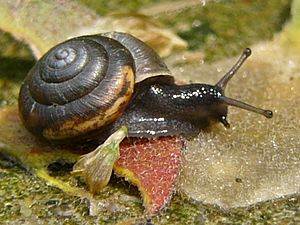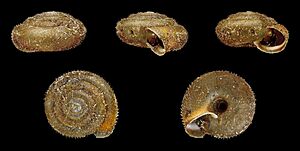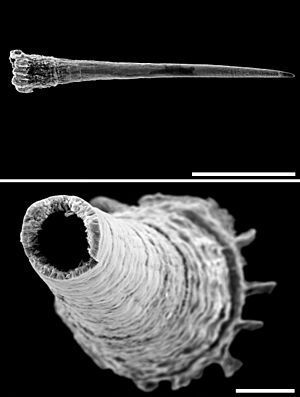Trochulus hispidus facts for kids
Trochulus hispidus, often called the hairy snail, is a type of air-breathing land snail. It is a small mollusk that lives on land and belongs to the family Hygromiidae, which includes many other "hairy snails." This snail was once known by the name Trichia hispida.
Quick facts for kids Trochulus hispidus |
|
|---|---|
 |
|
| A live individual of Trochulus hispidus (an older adult with most of the hairs worn off of the shell) | |
 |
|
| Five views of a shell of Trochulus hispidus | |
| Conservation status | |
| Scientific classification | |
| Synonyms | |
|
Trichia hispida |
Contents
Where the Hairy Snail Lives
The hairy snail can be found in many countries and islands across Europe.
It lives in:
- Western Europe:
* Great Britain and Ireland * Netherlands, Belgium, Luxembourg * Faroe Islands * France * Switzerland, Liechtenstein
- Northern Europe:
* Denmark, Norway, Sweden, Finland
- Central Europe:
* Austria, Germany, Czech Republic, Poland, Slovakia, Hungary, Romania
- Southern Europe:
* Andorra, Spain, Italy, Bulgaria
- Eastern Europe:
* Moldova * Estonia, Latvia, Lithuania * Ukraine * Russian Federation (Kaliningrad area)
What Does the Hairy Snail Look Like?
The shell of the hairy snail is usually 3 to 6 millimeters tall and 5 to 11 millimeters wide. It has 5 to 6 rounded spirals, called whorls. The opening of the shell, called the aperture, has a thin white edge inside.
The center of the shell's underside has an open hole, called the umbilicus. This hole is usually wide, about 1/8 to 1/4 of the shell's total width. The shell can be brown or cream in color, sometimes with a lighter band around its middle.
The shell's outer layer, called the periostracum, has small, curved hairs. These hairs are about 0.2 to 0.3 millimeters long and cover the shell densely. If the hairs wear off from most of the shell, they often remain inside the umbilicus. When hairs are lost, they leave small marks on the shell.
The snail's body is brownish-grey, with the front part being a bit darker.
How Hairy Snails Reproduce
Before mating, hairy snails use something called a love dart. This dart is shaped like a thorn. Snails use these darts as part of their courtship.
Scientists have also studied the eyes of Trochulus hispidus to learn more about how they see.
Hairy Snail Life and Habits
The eggs of the hairy snail are about 1.5 millimeters in size.
Sometimes, snails can travel in surprising ways! In 2010, a hairy snail was found on a great tit bird in Poland. This shows that even small birds can sometimes carry snails from one place to another.



